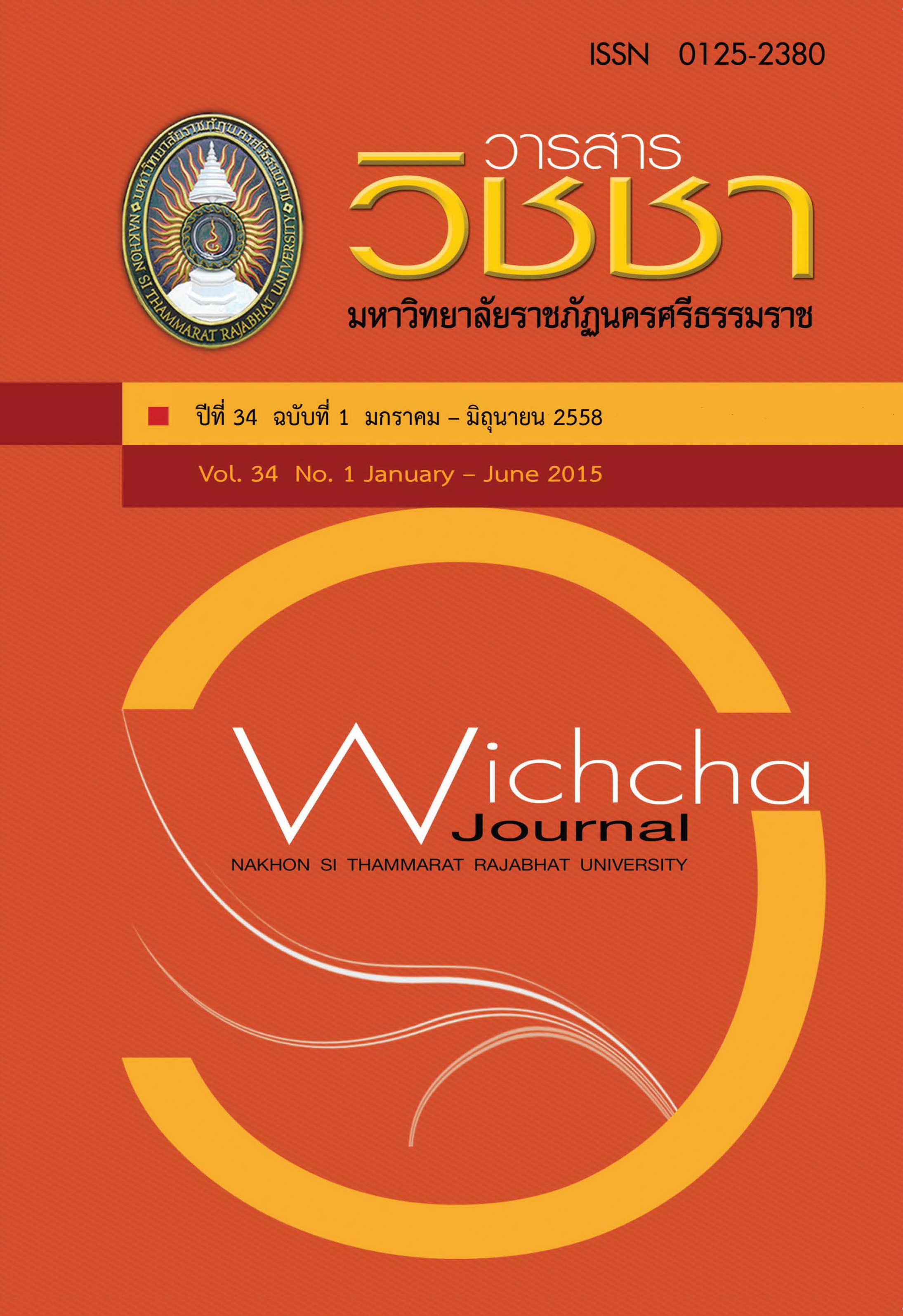ประสิทธิภาพของระบบเอสบีอาร์ในการบำบัดน้ำเสียอุตสาหกรรมฟอกย้อม Efficiency of Sequencing Batch Reactor (SBR) System for Treatment of Textile Wastewater
Main Article Content
Abstract
งานวิจัยนี้มีวัตถุประสงค์เพื่อศึกษาประสิทธิภาพของระบบเอสบีอาร์ในการบำบัดน้ำเสียสังเคราะห์ที่ปนเปื้อนสีย้อมไดเร็กท์ (Direct Red 23 และ Direct Blue 15) โดยทำการศึกษา 2 การทดลองคือ 1) ผลของความเข้มข้นของตะกอนจุลินทรีย์ (Mixed Liquor Suspended Solids; MLSS)ที่ความเข้มข้นของจุลินทรีย์เท่ากับ 1,500 2,500 และ 3,500 มก./ล. และ 2) ผลของระยะเวลากักเก็บน้ำ(Hydraulic Retention Time; HRT) ที่ระยะเวลากักเก็บน้ำเท่ากับ 2.5, 5 และ 7.5 วัน (หรือมีอัตราภาระบรรทุกภาระสารอินทรีย์เท่ากับ 0.34, 0.17 และ 0.11 กก. บีโอดี/ลบ.ม.-วัน ตามลำดับ) การทดลองนี้มีวัฏจักรเท่ากับ 24 ชั่วโมง ผลการศึกษาพบว่า ประสิทธิภาพในการบำบัดสีย้อมและสารอินทรีย์ด้วยระบบเอสบีอาร์ จะมีแนวโน้มสูงขึ้นเมื่อมีความเข้มข้นของตะกอนจุลินทรีย์ที่เหมาะสมและที่ระยะเวลาเก็บกักน้ำที่สูงขึ้น (อัตราภาระบรรทุกสารอินทรีย์มีค่าลดลง) นอกจากนี้ระบบบำบัดยังมีประสิทธิภาพในการบำบัดสี Direct Red 23 สูงกว่าสี Direct Blue 15 และเมื่อควบคุมระบบบำบัดดังกล่าวที่ความเข้มข้นของตะกอนจุลินทรีย์เท่ากับ 2,500 มก./ล. และระยะเวลากักเก็บน้ำเท่ากับ 7.5 วัน (อัตราภาระบรรทุกสารอินทรีย์เท่ากับ 0.11 กก. บีโอดี/ลบ.ม.-วัน) ระบบจะมีประสิทธิภาพ ในการกำจัดสีย้อมและบำบัดสารอินทรีย์สูงที่สุด คือมากกว่าร้อยละ 90 นอกจากนี้ ระบบบำบัดแบบเอสบีอาร์ยังสามารถบำบัดสารอินทรีย์ไนโตรเจนในรูปของแอมโมเนียไนไตรท์และไนเตรทได้ดีอีกด้วย
The research aimed to observe the efficiency of sequencing batch reactor (SBR) system with synthetic wastewater containing direct dyes (Direct Red 23 and Direct Blue 15). The study consisted of two experiments. Firstly, the effect of MLSS on the efficiency of SBR system under various MLSS of 1,500 2,500 and 3,500 mg/L was investigated. Second, the effect of HRT under various HRT of 2.5, 5 and 7.5 days (organic loading rate of 0.34, 0.17 and 0.11 BOD5/m3-d, respectively) was also determined. The cycle of SBR operation was 24 hours. The results showed that the removal efficiency of the SBR tended to increase with the optimum MLSS operation and increase of HRT operation (decrease of organic loading rate). Moreover, the system showed the higher color removal efficiency with Direct Blue 15 than that with Direct Red 23. The system at MLSS of 2,500 mg/L and HRT of 7.5 days (organic loading rate of 0.11 kg BOD5/m3-d) gave the higest color and organic removal efficiencies of more than 90%. Moreover, the SBR system can treat organic nitrogen (ammonia, nitrite and nitrate forms) as well.
Article Details
เนื้อหาและข้อมูลในบทความที่ลงตีพิมพ์ในวารสารวิชชา มหาวิทยาลัยราชภัฏนครศรีธรรมราช ถือเป็นข้อคิดเห็นและความรับผิดชอบของผู้เขียนบทความโดยตรง ซึ่งกองบรรณาธิการวารสารไม่จำเป็นต้องเห็นด้วยหรือร่วมรับผิดชอบใด ๆ
บทความ ข้อมูล เนื้อหา รูปภาพ ฯลฯ ที่ได้รับการตีพิมพ์ในวารสารวิชชา มหาวิทยาลัยราชภัฏนครศรีธรรมราช ถือเป็นลิขสิทธ์ของวารสารวิชชา มหาวิทยาลัยราชภัฏนครศรีธรรมราช หากบุคคลหรือหน่วยงานใดต้องการนำข้อมูลทั้งหมดหรือส่วนหนึ่งส่วนใดไปเผยแพร่ต่อหรือเพื่อการกระทำการใด ๆ จะต้องได้รับอนุญาตเป็นลายลักษณ์อักษรจากวารสารวิชชา มหาวิทยาลัยราชภัฏนครศรีธรรมราชก่อนเท่านั้น
The content and information in the article published in Wichcha journal Nakhon Si Thammarat Rajabhat University, It is the opinion and responsibility of the author of the article. The editorial journals do not need to agree. Or share any responsibility.

